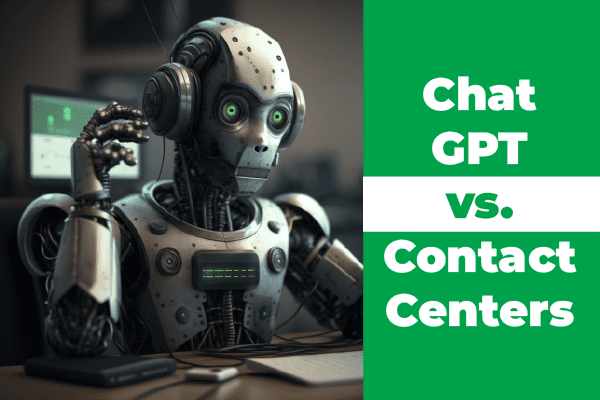As customer service demands continue to grow, contact centers are constantly on the lookout for innovative solutions to enhance their operations. ChatGPT, the advanced AI language model developed by OpenAI, has emerged as a promising tool for contact centers to improve customer interactions and streamline processes. This article delves into the potential of ChatGPT in contact centers and how it can revolutionize the customer service landscape.
According to Muddu Sudhakar, Forbes Councils Member, generative AI and automation are making the contact center a highly efficient and near-human-like communication resource.
It’s also rumored that ChatGPT might render a good number of jobs obsolete, careers in education, finance, software engineering, journalism, and graphic design are under jeopardy. – Alex Mitchell – NYPost
Let’s see if the contact center industry is going to be affected by this.
But first, let’s define generative AI. Generative AI refers to a type of artificial intelligence that can create new content, such as text or images, based on a given set of inputs. ChatGPT is an example of generative AI, as it is designed to generate natural language text that is similar to human speech.
What is ChatGPT, and why should you care?
ChatGPT is an AI-powered conversational agent that can understand and generate human-like language. It uses a deep learning model to analyze text and generate responses based on its understanding of natural language. This technology has several applications, including chatbots, virtual assistants, and other conversational interfaces. ChatGPT has been trained on a massive dataset of human language, making it capable of understanding complex questions and generating accurate responses.
Can you start to envision where this is going and the impact generative AI can (and most likely will) have on the contact center industry?
Just to be clear about the consequences, according to Gartner, by 2026, conversational artificial intelligence (AI) deployments within contact centers will reduce agent labor costs by $80 billion.
In other words, the stakes are high.
But wait, there’s more; in the same article, Gartner estimates that one in 10 agent interactions will be automated by 2026.
Why Should Contact Centers Consider Adopting ChatGPT?
 Alright, if the macro-view was not enough to spark your interest, let’s loo at a non-comprehensive list of arguments that might entice your curiosity. (We will discuss these benefits in more detail in the second part of this article.)
Alright, if the macro-view was not enough to spark your interest, let’s loo at a non-comprehensive list of arguments that might entice your curiosity. (We will discuss these benefits in more detail in the second part of this article.)
Again, according to the before cited Forbes article, chatbots can increase customer satisfaction rates by up to 25%.
Integrating ChatGPT into contact center operations can offer several benefits, including:
- Enhanced customer experience: ChatGPT can handle multiple customer queries simultaneously, providing accurate and prompt responses. This not only reduces wait times but also improves overall customer satisfaction.
In general, it is believed that generative AI can enhance customer experience in contact centers by transforming the way they operate, improving response times and enabling personalized interactions that elevate customer experience. By automating routine tasks and enhancing communication, businesses can deliver superior service while increasing operational efficiency. - Cost reduction: As we saw before, probably the biggest incentive to integrate a generative AI within your contact center business or department is the promise that it will significantly reduce the agent labour costs. In short, by automating routine tasks and inquiries, ChatGPT reduces the need for human agents, lowering operational costs.
- Scalability:As an AI-based solution, ChatGPT can easily scale up or down based on the contact center’s needs, ensuring consistent service quality during peak periods. To be more clear, imagine the workforce challenges a contact center manager has to go through before launching a new campaign. Assembling and training a new team is probably the most cost-heavy and time-consuming task. Well, a fully integrated AI solution would ideally lose all that.
- Improved agent efficiency:ChatGPT can assist human agents by providing relevant information and suggestions, enabling them to resolve customer issues more effectively. Infusing AI into core applications like ACDs, IVRs, and even workforce management can transform how contact centers route interactions, forecast volume, provide self-service, develop agents, and analyze performance.
You can learn how AI technology is already applied to our customers by visiting the NobelBiz & Balto partnership page.
Generative AI and customer support
One of the most promising applications of generative AI in customer support is in the area of chatbots. Chatbots are computer programs that can simulate conversations with human users, and they are often used to handle routine customer inquiries and support requests.
By integrating generative AI technology like ChatGPT into chatbots, companies can potentially improve the accuracy and relevance of their responses. Chatbots can learn from the interactions they have with customers, and over time, they can become better at understanding and responding to their needs.
One more hurdle to overcome: Empathy
 However, while chatbots have shown promise in handling routine customer inquiries, they are not yet capable of replacing human agents in more complex or sensitive situations. Chatbots lack the empathy and emotional intelligence that humans possess, and they may struggle to handle situations that require nuanced communication or delicate problem-solving.
However, while chatbots have shown promise in handling routine customer inquiries, they are not yet capable of replacing human agents in more complex or sensitive situations. Chatbots lack the empathy and emotional intelligence that humans possess, and they may struggle to handle situations that require nuanced communication or delicate problem-solving.
For example, imagine a customer who is upset about a problem with their account. A human agent would likely be able to empathize with the customer, listen to their concerns, and work with them to find a solution. A chatbot, on the other hand, may not be able to detect the customer’s emotional state, and it may provide responses that seem insensitive or unhelpful.
This is where the concept of assisted intelligence comes in. Assisted intelligence refers to the use of AI technology to support human agents in their work. Rather than replacing agents, AI can be used to augment their abilities and help them provide better customer service. Learn more here.
This doesn’t mean that present AI applications can’t aid agents:
One way that AI can assist human agents is by providing them with relevant information and suggestions in real-time. For example, if a customer asks a question that the agent is not sure how to answer, an AI system could provide suggestions for how to respond based on previous interactions with similar customers or common best practices.
80% of customer interactions will be handled by conversational AI by 2025 – Forbes
Another way that AI can assist agents is by helping them handle routine tasks more efficiently. For example, an AI system could automatically route incoming calls or emails to the appropriate agent based on the customer’s needs and the agent’s expertise (the routing capabilities we were previously mentioning). This would save agents time and allow them to focus on more complex and high-value tasks.
Ultimately, the goal of assisted intelligence is to create a more efficient and effective contact center that provides better service to customers.
By leveraging the strengths of both humans and machines, companies can provide a better customer experience while also improving their bottom line. – Christian Montes, Executive Vice President Client Operations @ NobelBiz
So, is ChatGPT coming for the contact center?
Not yet, but it may have value in assisting agents. While generative AI has shown promise in handling routine customer inquiries, it is not yet capable of replacing human agents in more complex or sensitive situations. Instead, AI should be seen as a tool that can help human agents provide better customer service.
As technology continues to evolve and improve, we can expect to see more companies integrating AI into their contact centers in the coming years. However, it will be important to approach this integration carefully and thoughtfully, with a focus on improving the contact center metrics.
How can ChatGPT help contact centers?
As mentioned earlier, ChatGPT is not coming for contact centers just yet, but it does have the potential to assist human agents and improve overall customer experience. Let’s further explore some ways in which ChatGPT can be used in the contact center industry.
1. Improving Customer Service with ChatGPT
 ChatGPT can be used to enhance customer service by providing agents with real-time insights and solutions. ChatGPT can be trained to recognize common customer complaints and suggest the best response to the agent. For example, if a customer is complaining about a product not working, ChatGPT can suggest a troubleshooting guide or recommend a replacement.
ChatGPT can be used to enhance customer service by providing agents with real-time insights and solutions. ChatGPT can be trained to recognize common customer complaints and suggest the best response to the agent. For example, if a customer is complaining about a product not working, ChatGPT can suggest a troubleshooting guide or recommend a replacement.
As per an article from No Jitter, Will ChatGPT represent the future of customer service:
‘’This new tech could truly personalize communications, factoring in people’s individual communication and engagement styles, and their personal preferences.’’
Here are some ways businesses can leverage ChatGPT for customer support:
• Use ChatGPT for Tier 1 Support: Businesses can use ChatGPT to handle basic customer queries and complaints, freeing up human agents to focus on more complex issues.
• Automating responses to frequently asked questions: ChatGPT can be used to answer common customer queries, such as operating hours, return policies, or product information, freeing up human agents to handle more complex issues.
• Triage and routing: ChatGPT can help categorize and route customer inquiries to the appropriate department or support agent, ensuring a faster and more accurate response.
• Assisting live chat agents: By integrating ChatGPT into live chat systems, it can provide real-time suggestions or even draft responses for human agents, helping them respond more quickly and accurately to customer queries.
• Handling after-hours support: ChatGPT can be used to offer 24/7 customer support, answering basic questions or gathering information from customers during off-hours, ensuring they receive assistance even when live agents are not available.
• Email support: ChatGPT can help draft or even fully automate responses to customer support emails, increasing efficiency and reducing response times.
• Social media monitoring and engagement: Last but not least, ChatGPT can monitor social media platforms for customer inquiries or complaints, responding to them or escalating them to the appropriate personnel as needed.
2. Automating Repetitive Tasks
Contact centers often have to handle a large volume of repetitive tasks such as answering common questions, verifying account information, and processing refunds. ChatGPT can be trained to automate these tasks, freeing up human agents to focus on more complex and high-value interactions. This can improve overall efficiency and reduce wait times for customers.
3. Providing Multilingual Support
With proper training, generative AI can provide customer support in multiple languages, making it easier for businesses to cater to a global audience.
ChatGPT can be trained in multiple languages, making it an ideal solution for contact centers that operate in multiple countries. This can help reduce language barriers and provide a more seamless customer experience. ChatGPT can also be trained to understand different accents and dialects, further enhancing its language capabilities.
4. Enhancing Employee Training and Development
ChatGPT can be used to train new employees and assist in their development. It can be trained to provide onboarding information and answer common questions, reducing the time and resources required for human training. ChatGPT can also provide feedback and coaching to agents, helping them improve their skills and performance.
In short, generative AI can revolutionize contact center training by offering personalized learning experiences, simulating realistic customer interactions, generating educational content, and streamlining the overall training process.
Generative AI in an omnichannel contact center environment
 Now, the trend is clear. Every single contact center that doesn’t want to be left behind is considering adopting an omnichannel approach. And as you might have guessed, AI has the potential to excel in an omnichannel contact center environment. How? By enhancing customer experience and streamlining support across various channels. Let’s see how AI can contribute to an omnichannel contact center:
Now, the trend is clear. Every single contact center that doesn’t want to be left behind is considering adopting an omnichannel approach. And as you might have guessed, AI has the potential to excel in an omnichannel contact center environment. How? By enhancing customer experience and streamlining support across various channels. Let’s see how AI can contribute to an omnichannel contact center:
Consistent support across channels: Generative AI can ensure that customers receive consistent information and assistance, regardless of whether they’re reaching out through live chat, email, social media, or other platforms.
Seamless integration: AI can be easily integrated into existing contact center systems, enabling it to work in tandem with human agents and other support tools to provide a unified customer experience.
Real-time data analysis: Generative AI can analyze customer interactions across multiple channels, identifying trends, preferences, and pain points, enabling businesses to optimize their support strategies and enhance the overall customer journey.
Personalized experience: By gathering and processing customer data from various touchpoints, generative AI can provide personalized support and recommendations, resulting in a more tailored and satisfying customer experience.
If you’re in the market for a complete omnichannel contact center solution, take a couple of minutes to consider OMNI+, the cloud contact center software with full omnichannel capabilities from NobelBiz.
How can ChatGPT Reduce Costs for Contact Centers?
 Cost reduction is a top priority for businesses, and ChatGPT’s potential to streamline operations makes it an attractive option. Let’s examine how ChatGPT can help reduce costs in contact centers.
Cost reduction is a top priority for businesses, and ChatGPT’s potential to streamline operations makes it an attractive option. Let’s examine how ChatGPT can help reduce costs in contact centers.
Integrating ChatGPT into contact centers can enhance the scalability of customer support, allowing businesses to handle higher volumes of inquiries without a proportional increase in staffing costs. This AI-driven approach results in cost-effective growth and improved customer satisfaction. – Michael McGuire, Senior Contact Center Software Consultant @ NobelBiz
• Decreased Staffing Costs: By handling routine customer queries, ChatGPT reduces the number of human agents required for customer support. This leads to lower staffing costs and more efficient use of resources.
• Lower Training Expenses: As ChatGPT is capable of learning and updating its knowledge base, the need for extensive agent training is reduced. This translates to cost savings in training and development.
• Improved Customer Retention: A high level of customer satisfaction, facilitated by ChatGPT, can lead to increased customer retention. In turn, this reduces the costs associated with acquiring new customers.
What Are the Potential Challenges in Implementing ChatGPT in Contact Centers?
 Despite its numerous advantages, there are potential challenges to consider when adopting ChatGPT in contact centers:
Despite its numerous advantages, there are potential challenges to consider when adopting ChatGPT in contact centers:
Data privacy and security: Ensuring the protection of sensitive customer information is paramount when using AI-based tools like ChatGPT.
AI bias: ChatGPT may inadvertently generate biased or inappropriate content. It’s essential to monitor and fine-tune the model to minimize such risks.
Training and integration: Successful implementation of ChatGPT requires time and resources for training and integration with existing systems.
Ongoing maintenance: Like any AI system, ChatGPT requires regular updates and maintenance to ensure optimal performance.
Job Displacement: The adoption of ChatGPT in contact centers raises concerns about job displacement for human agents. Businesses must strike a balance between leveraging AI capabilities and maintaining a human touch in their customer support operations.
Cost: Last but not least, we have to consider the cost of a smart contact center. In this regard, Gartner estimates integration pricing at $1,000 to $1,500 per conversational AI agent, though some organizations cite costs of up to $2,000 per agent.
In Conclusion: ChatGPT’s Impact on Contact Centers
Is ChatGPT coming for the contact center? The answer seems to be a resounding yes. ChatGPT’s ability to enhance customer support, increase operational efficiency, and reduce costs makes it an attractive solution for contact centers.
However, businesses must be mindful of potential challenges, such as data privacy and job displacement, while integrating ChatGPT into their operations. By adopting a hybrid approach, investing in employee skill development, and developing a comprehensive AI strategy, contact centers can successfully harness the power of ChatGPT to revolutionize the customer support landscape.

Michael McGuire is a contact center industry expert with almost two decades of experience in the space. His experience includes roles as Director of Contact Center Digital Transformation at NobelBiz, and as Director of Operations at FLS Connect, managing multiple call centers. As President of Anomaly Squared and Targeted Metrics, Michael successfully transitioned companies into remote operations and significantly boosted revenues. With a strong background in customer service, leadership, strategic planning, and operations management, Michael excels in driving growth and innovation in the call center space.
Mike is also a proud Board Member for R.E.A.C.H Trade Group, promoting consumer protection and satisfaction and Co-host of the Off Skripted Podcast – a show about Life, Call Centers and everything in between.







